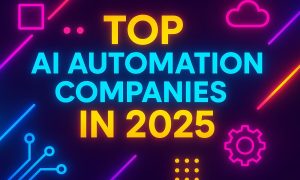

Future of AI in Healthcare, Education, Finance, and Manufacturing (2025-2030)
AI is rapidly transforming various industries, with significant advances forecasted by 2025 and 2030. This article explains how AI will shape key sectors such as healthcare, education, finance, and manufacturing, as well as new areas like automotive, pharma, aerospace, defense, and robotics across different regions including the UK, Europe, Asia, India, China, Japan, and Latin America.
AI in Healthcare
1. UK and Europe
By 2030, AI-powered tools in healthcare will revolutionize the diagnosis and treatment of chronic diseases, cancer detection, and personalized medicine. In the UK, AI-driven medical imaging and predictive analytics are expected to streamline diagnostics, with Europe seeing an expansion in digital health platforms integrating AI to monitor patient data. AI healthcare spending in Europe is projected to hit $45 billion by 2030.
2. Asia (India, China, Japan)
Asia is embracing AI for telemedicine, robotics in surgeries, and AI in drug discovery. China is investing heavily in AI for clinical decision-making and healthcare automation, while Japan is deploying AI to support its aging population with elder care and smart health monitoring systems.
3. Latin America
In Latin America, AI’s role in healthcare will focus on improving accessibility. Telemedicine platforms and AI-powered diagnostic tools will become common, helping to mitigate healthcare disparities. By 2030, AI adoption in the healthcare sector is expected to reach $10 billion in the region.
AI in Education
4. UK and Europe
AI is set to redefine education in the UK and Europe by offering personalized learning experiences and predictive tools to improve student outcomes. AI-based tutoring systems and virtual classrooms will become standard, helping educators address student needs more effectively.
5. Asia (India, China, Japan)
China and India are utilizing AI-powered e-learning platforms that offer tailored education solutions. By 2030, AI in education across Asia will be integral in bridging gaps in rural and urban education through adaptive learning algorithms and real-time student monitoring.
6. Latin America
Latin America’s educational sector will see AI transforming online learning and distance education. AI-powered systems will help students in underserved regions access quality education. The adoption of AI-driven learning platforms is expected to surge, reaching $5 billion by 2030.
AI in Finance
7. UK and Europe
The finance sector in the UK and Europe is undergoing significant AI transformation, with AI-driven risk management, fraud detection, and algorithmic trading leading the change. By 2030, AI in fintech is expected to add $300 billion in economic value.
8. Asia (India, China, Japan)
In Asia, particularly China and India, AI is revolutionizing banking and finance through digital payments, automated trading, and personalized financial services. AI in China’s financial sector is expected to contribute $80 billion by 2030.
9. Latin America
AI is improving financial inclusion in Latin America by providing AI-driven micro-loans, risk analysis, and fraud prevention tools. AI-powered fintech startups in Brazil and Mexico are driving this growth, with projections indicating a $20 billion market by 2030.
AI in Manufacturing
10. UK and Europe
AI will optimize Europe’s manufacturing processes through predictive maintenance, supply chain management, and quality control. AI-driven automation and robotics will enhance production efficiency, reducing operational costs by 10-15%.
11. Asia (India, China, Japan)
China and Japan are leading AI adoption in manufacturing with smart factories that integrate AI to streamline operations. India’s “Make in India” initiative will benefit from AI in supply chain automation and production optimization. By 2030, AI in Asian manufacturing will contribute $45 billion.
12. Latin America
Latin America is gradually adopting AI in manufacturing, focusing on automation in industries such as automotive and electronics. By 2030, AI applications in Latin American manufacturing will enhance productivity and reduce production costs.
AI in Automotive
13. Global Trends
AI is integral to the future of the automotive industry, particularly in autonomous vehicles, predictive maintenance, and in-car personal assistants. By 2030, the global AI automotive market is expected to exceed $200 billion(Fullpath). AI-driven systems will make vehicles safer and more efficient, with autonomous driving and advanced driver-assistance systems (ADAS) leading innovation.
AI in Pharma
14. UK and Europe
The pharmaceutical industry in Europe is leveraging AI to enhance drug discovery and clinical trials. AI algorithms can analyze vast datasets to identify potential drug candidates more quickly, reducing the time to market.
15. Asia
China and Japan are utilizing AI to speed up drug discovery and optimize clinical trials. AI-powered simulations in pharma will reduce the need for extensive animal testing, bringing more effective drugs to market faster by 2030.
AI in Aerospace
16. Global Trends
AI in aerospace is revolutionizing aircraft design, flight operations, and predictive maintenance. AI-driven systems in flight planning and air traffic control are expected to enhance fuel efficiency and reduce delays. By 2030, AI in the aerospace industry is projected to contribute $50 billion in value(Deloitte United States).
AI in Defense
17. Global Trends
AI’s role in defense is growing, with applications ranging from autonomous drones to cybersecurity. AI will be crucial for military operations, with AI-powered drones and robots enhancing surveillance and combat strategies. By 2030, AI in defense is expected to revolutionize battlefield tactics(Cypris)(Deloitte United States).
AI in Robotics
18. Global Trends
AI-driven robots are transforming industries from manufacturing to healthcare. Cobots (collaborative robots) will work alongside humans in factories, while humanoid robots will assist in retail and customer service(Analytics Insight). By 2030, the global AI robotics market is projected to reach $100 billion(IFR International Federation of Robotics).
Conclusion
AI is poised to redefine industries across healthcare, education, finance, manufacturing, and more by 2030. The rapid adoption of AI technologies will create unprecedented opportunities for innovation, efficiency, and growth in both developed and emerging markets. Governments, businesses, and educators must be prepared to harness the potential of AI to maximize these benefits.
References
- McKinsey, “The Future of AI in Industries”
- Deloitte Insights, “2024 Aerospace and Defense Outlook”
- International Federation of Robotics, “Top Robot Trends 2024”
- Fullpath, “AI in Automotive”
- Analytics Insight, “AI and Robotics Trends for 2025”



























